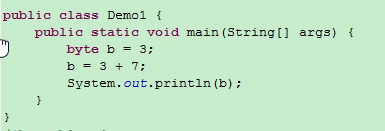Netty学习08--自定义序列化协议之自定义序列化协议
Serializerpackage core;import java.nio.charset.Charset;import java.util.ArrayList;import java.util.Collection;import java.util.HashMap;import java.util.List;import java.util.Map;import java.util.Map.Entry;import org.jboss.netty.buffer.ChannelBuffer;/*** 自定义序列化接口*/public abstract class Serializer {public static final Charset CHARSET = Charset.forName("UTF-8");protected ChannelBuffer writeBuffer;protected ChannelBuffer readBuffer;/*** 反序列化具体实现*/protected abstract void read();/*** 序列化具体实现*/protected abstract void write();/*** 从byte数组获取数据* @param bytes 读取的数组*/public Serializer readFromBytes(byte[] bytes) {readBuffer = BufferFactory.getBuffer(bytes);read();readBuffer.clear();return this;}/*** 从buff获取数据* @param readBuffer*/public void readFromBuffer(ChannelBuffer readBuffer) {this.readBuffer = readBuffer;read();}/*** 写入本地buff* @return*/public ChannelBuffer writeToLocalBuff(){writeBuffer = BufferFactory.getBuffer();write();return writeBuffer;}/*** 写入目标buff* @param buffer* @return*/public ChannelBuffer writeToTargetBuff(ChannelBuffer buffer){writeBuffer = buffer;write();return writeBuffer;}/*** 返回buffer数组** @return*/public byte[] getBytes() {writeToLocalBuff();byte[] bytes = null;if (writeBuffer.writerIndex() == 0) {bytes = new byte[0];} else {bytes = new byte[writeBuffer.writerIndex()];writeBuffer.readBytes(bytes);}writeBuffer.clear();return bytes;}public byte readByte() {return readBuffer.readByte();}public short readShort() {return readBuffer.readShort();}public int readInt() {return readBuffer.readInt();}public long readLong() {return readBuffer.readLong();}public float readFloat() {return readBuffer.readFloat();}public double readDouble() {return readBuffer.readDouble();}public String readString() {int size = readBuffer.readShort();if (size <= 0) {return "";}byte[] bytes = new byte[size];readBuffer.readBytes(bytes);return new String(bytes, CHARSET);}public <T> List<T> readList(Class<T> clz) {List<T> list = new ArrayList<>();int size = readBuffer.readShort();for (int i = 0; i < size; i++) {list.add(read(clz));}return list;}public <K,V> Map<K,V> readMap(Class<K> keyClz, Class<V> valueClz) {Map<K,V> map = new HashMap<>();int size = readBuffer.readShort();for (int i = 0; i < size; i++) {K key = read(keyClz);V value = read(valueClz);map.put(key, value);}return map;}@SuppressWarnings("unchecked")public <I> I read(Class<I> clz) {Object t = null;if ( clz == int.class || clz == Integer.class) {t = this.readInt();} else if (clz == byte.class || clz == Byte.class){t = this.readByte();} else if (clz == short.class || clz == Short.class){t = this.readShort();} else if (clz == long.class || clz == Long.class){t = this.readLong();} else if (clz == float.class || clz == Float.class){t = readFloat();} else if (clz == double.class || clz == Double.class){t = readDouble();} else if (clz == String.class ){t = readString();} else if (Serializer.class.isAssignableFrom(clz)){try {byte hasObject = this.readBuffer.readByte();if(hasObject == 1){Serializer temp = (Serializer)clz.newInstance();temp.readFromBuffer(this.readBuffer);t = temp;}else{t = null;}} catch (Exception e) {e.printStackTrace();}} else {throw new RuntimeException(String.format("不支持类型:[%s]", clz));}return (I) t;}public Serializer writeByte(Byte value) {writeBuffer.writeByte(value);return this;}public Serializer writeShort(Short value) {writeBuffer.writeShort(value);return this;}public Serializer writeInt(Integer value) {writeBuffer.writeInt(value);return this;}public Serializer writeLong(Long value) {writeBuffer.writeLong(value);return this;}public Serializer writeFloat(Float value) {writeBuffer.writeFloat(value);return this;}public Serializer writeDouble(Double value) {writeBuffer.writeDouble(value);return this;}public <T> Serializer writeList(List<T> list) {if (isEmpty(list)) {writeBuffer.writeShort((short) 0);return this;}writeBuffer.writeShort((short) list.size());for (T item : list) {writeObject(item);}return this;}public <K,V> Serializer writeMap(Map<K, V> map) {if (isEmpty(map)) {writeBuffer.writeShort((short) 0);return this;}writeBuffer.writeShort((short) map.size());for (Entry<K, V> entry : map.entrySet()) {writeObject(entry.getKey());writeObject(entry.getValue());}return this;}public Serializer writeString(String value) {if (value == null || value.isEmpty()) {writeShort((short) 0);return this;}byte data[] = value.getBytes(CHARSET);short len = (short) data.length;writeBuffer.writeShort(len);writeBuffer.writeBytes(data);return this;}public Serializer writeObject(Object object) {if(object == null){writeByte((byte)0);}else{if (object instanceof Integer) {writeInt((int) object);return this;}if (object instanceof Long) {writeLong((long) object);return this;}if (object instanceof Short) {writeShort((short) object);return this;}if (object instanceof Byte) {writeByte((byte) object);return this;}if (object instanceof String) {String value = (String) object;writeString(value);return this;}if (object instanceof Serializer) {writeByte((byte)1);Serializer value = (Serializer) object;value.writeToTargetBuff(writeBuffer);return this;}throw new RuntimeException("不可序列化的类型:" + object.getClass());}return this;}private <T> boolean isEmpty(Collection<T> c) {return c == null || c.size() == 0;}public <K,V> boolean isEmpty(Map<K,V> c) {return c == null || c.size() == 0;}}BufferFactorypackage core;import java.nio.ByteOrder;import org.jboss.netty.buffer.ChannelBuffer;import org.jboss.netty.buffer.ChannelBuffers;/*** buff工厂*/public class BufferFactory {public static ByteOrder BYTE_ORDER = ByteOrder.BIG_ENDIAN;/*** 获取一个buffer** @return*/public static ChannelBuffer getBuffer() {ChannelBuffer dynamicBuffer = ChannelBuffers.dynamicBuffer();return dynamicBuffer;}/*** 将数据写入buffer* @param bytes* @return*/public static ChannelBuffer getBuffer(byte[] bytes) {ChannelBuffer copiedBuffer = ChannelBuffers.copiedBuffer(bytes);return copiedBuffer;}}Test1import java.io.ByteArrayInputStream;import java.io.ByteArrayOutputStream;import java.io.IOException;import java.util.Arrays;public class Test1 {public static void main(String[] args) throws IOException {int id = 101;int age = 21;ByteArrayOutputStream arrayOutputStream = new ByteArrayOutputStream();arrayOutputStream.write(int2bytes(id));arrayOutputStream.write(int2bytes(age));byte[] byteArray = arrayOutputStream.toByteArray();System.out.println(Arrays.toString(byteArray));//==============================================================ByteArrayInputStream arrayInputStream = new ByteArrayInputStream(byteArray);byte[] idBytes = new byte[4];arrayInputStream.read(idBytes);System.out.println("id:" + bytes2int(idBytes));byte[] ageBytes = new byte[4];arrayInputStream.read(ageBytes);System.out.println("age:" + bytes2int(ageBytes));}/*** 大端字节序列(先写高位,再写低位)* 百度下 大小端字节序列* @param i* @return*/public static byte[] int2bytes(int i){byte[] bytes = new byte[4];bytes[0] = (byte)(i >> 3*8);bytes[1] = (byte)(i >> 2*8);bytes[2] = (byte)(i >> 1*8);bytes[3] = (byte)(i >> 0*8);return bytes;}/*** 大端* @param bytes* @return*/public static int bytes2int(byte[] bytes){return (bytes[0] << 3*8) |(bytes[1] << 2*8) |(bytes[2] << 1*8) |(bytes[3] << 0*8);}}Test1上面的使用不方便,如果bytes2double又要重新写一个新的方法,比较麻烦,使用Test2Test2import java.nio.ByteBuffer;import java.util.Arrays;public class Test2 {public static void main(String[] args) {int id = 101;int age = 21;ByteBuffer buffer = ByteBuffer.allocate(8);buffer.putInt(id);buffer.putInt(age);byte[] array = buffer.array();System.out.println(Arrays.toString(buffer.array()));//====================================================ByteBuffer buffer2 = ByteBuffer.wrap(array);System.out.println("id:"+buffer2.getInt());System.out.println("age:"+buffer2.getInt());}}Test2这种方式必须先初始化一个大小,不会自动扩容。如果buffer.putLong(11L),会导致程序出错。Test3import java.util.Arrays;import org.jboss.netty.buffer.ChannelBuffer;import org.jboss.netty.buffer.ChannelBuffers;public class Test3 {public static void main(String[] args) {ChannelBuffer buffer = ChannelBuffers.dynamicBuffer();buffer.writeInt(101);buffer.writeDouble(80.1);byte[] bytes = new byte[buffer.writerIndex()];buffer.readBytes(bytes);System.out.println(Arrays.toString(bytes));"abc".getBytes();//================================================ChannelBuffer wrappedBuffer = ChannelBuffers.wrappedBuffer(bytes);System.out.println(wrappedBuffer.readInt());System.out.println(wrappedBuffer.readDouble());}}Test3就会自动扩容,但是不会写String类型的数据,("abc".getBytes();)使用Test4直接序列化和反序列化对象。Resourceimport core.Serializer;public class Resource extends Serializer {private int gold;public int getGold() {return gold;}public void setGold(int gold) {this.gold = gold;}@Overrideprotected void read() {this.gold = readInt();}@Overrideprotected void write() {writeInt(gold);}}Playerimport core.Serializer;import java.util.ArrayList;import java.util.List;public class Player extends Serializer {private long playerId;private int age;private List<Integer> skills = new ArrayList<>();private Resource resource = new Resource();public Resource getResource() {return resource;}public void setResource(Resource resource) {this.resource = resource;}public long getPlayerId() {return playerId;}public void setPlayerId(long playerId) {this.playerId = playerId;}public int getAge() {return age;}public void setAge(int age) {this.age = age;}public List<Integer> getSkills() {return skills;}public void setSkills(List<Integer> skills) {this.skills = skills;}@Overrideprotected void read() {this.playerId = readLong();this.age = readInt();this.skills = readList(Integer.class);this.resource = read(Resource.class);}@Overrideprotected void write() {writeLong(playerId);writeInt(age);writeList(skills);writeObject(resource);}}Test4 (使用前面定义的BufferFactory和Serializer)import java.util.Arrays;public class Test4 {public static void main(String[] args) {Player player = new Player();player.setPlayerId(10001);player.setAge(22);player.getSkills().add(101);player.getResource().setGold(99999);byte[] bytes = player.getBytes();System.out.println(Arrays.toString(bytes));//==============================================Player player2 = new Player();player2.readFromBytes(bytes);System.out.println(player2.getPlayerId() + " "+player2.getAge() + " "+ Arrays.toString(player2.getSkills().toArray())+" " +player2.getResource().getGold());}}
代码下载


























![洛谷——P2559 [AHOI2002]哈利·波特与魔法石 洛谷——P2559 [AHOI2002]哈利·波特与魔法石](https://image.dandelioncloud.cn/images/20210726/aa4b7f26f01340b19306a3c4d1988829.png)





还没有评论,来说两句吧...